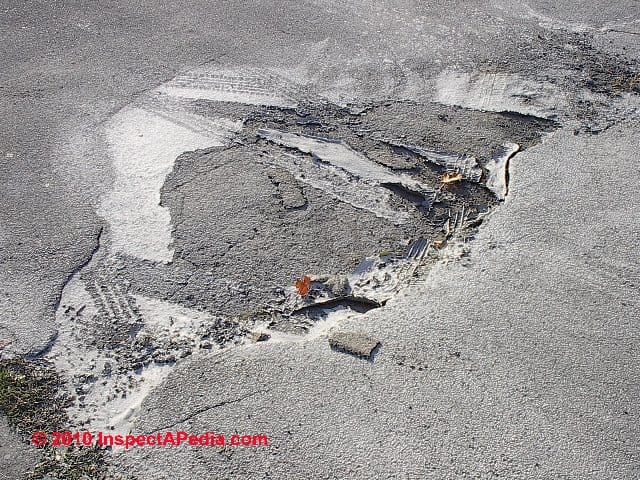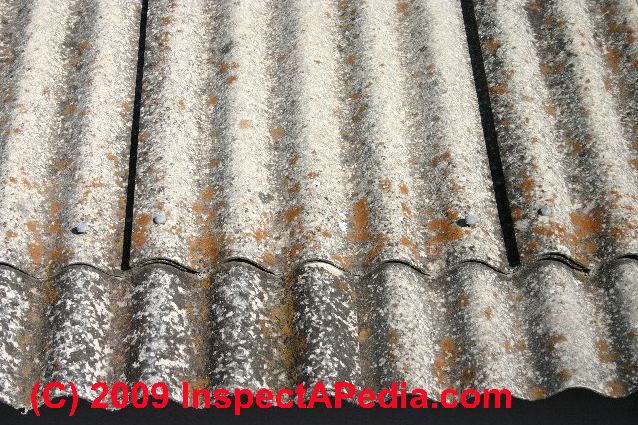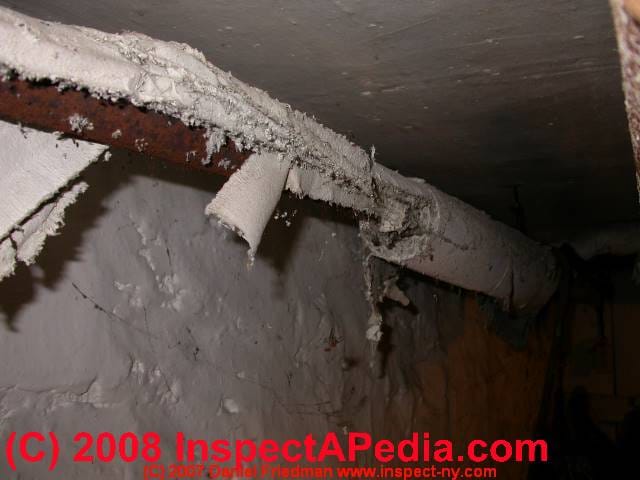 Asbestos, Lead, Mold Cleanup Certification & Training Warnings
Asbestos, Lead, Mold Cleanup Certification & Training Warnings
Asbestos removal certification
- POST a QUESTION or COMMENT about Asbestos, Lead, Mold Cleanup Jobs & Contractors
Certified asbestos remediators or labs: this article warns about un-supervised or un-trained environmental cleanup companies or work crews handling asbestos, lead, mold, and similar indoor contaminants, including identification of amateur or improper asbestos "abatement" projects that failed to properly remove materials or that left abandoned asbestos materials in place.
InspectAPedia tolerates no conflicts of interest. We have no relationship with advertisers, products, or services discussed at this website.
- Daniel Friedman, Publisher/Editor/Author - See WHO ARE WE?
Certification & Licensing for Asbestos, Lead Paint, or Mold Abatement, Removal, & Cleanup Companies:
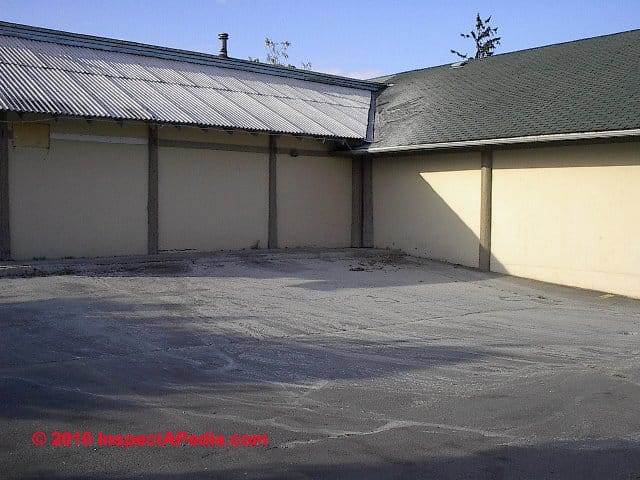 Consumer Warning about Environmental Cleanup Contractors
Consumer Warning about Environmental Cleanup Contractors
Watch out: As we introduced at ASBESTOS IDENTIFICATION IN BUILDINGS, building owners arranging for asbestos cleanup, or any other environmental cleanup for that matter, should be sure that the company they are using is properly certified, licensed, and that the work is conducted with proper supervision and by workers who themselves are properly trained.
[Click to enlarge any image]
Some problems we have found in the field when inspecting indoor asbestos, lead paint, mold, and other indoor environmental cleanup projects include:
- Asbestos, lead paint, mold, or other cleanup work performed without expert on-site supervision
by an experienced, well-trained job supervisor. Leaving workers, especially un-trained workers on the job without an expert supervisor increases the risks cited below.
An example of a typical lead paint "cleanup" snafu is provided below
at "Lead Paint Cleanup Troubles". - Work being performed by un-trained workers,
sometimes illegal immigrants who themselves are victims of companies who employ low-wage, un-trained workers and send them into dangerous environments without proper personal protection (respirators, eye protection, protective clothing, proper training). Such workers are very reluctant to ask questions or complain about inadequate protective gear, placing them at extra risk. - Improper air and dust containment barrier construction,
resulting in cross-contamination of other building areas by the very material being removed, resulting in a much greater ultimate project cost to properly clean the building. - Improper asbestos, mold, lead, or other hazardous material cleanup,
including failure to remove contaminated materials and taking shortcuts such as spraying or covering-over contaminated materials or surfaces.
In a project we inspected in Poughkeepsie, NY a real estate speculator hired an un-trained worker to place a layer of new drywall over interior walls that were highly contaminated with toxic mold. In another New York home following identification of asbestos-suspect heating pipe insulation during a home inspection the property owner elected to perform his own "asbestos cleanup". - His wife later informed us that the upstairs carpet and furniture became coated with a "thick white dust" as the owner tracked armloads of asbestos insulation through the building.
See ASBESTOS REMOVAL, Amateur, Incomplete for examples of amateur, incompetent environmental cleanup work involving asbestos. - Failure to properly dispose
of asbestos or other environmental cleanup debris and contaminated materials.
See ASBESTOS CEMENT ROOF WASHING TROUBLES for an example. - Exposure of building occupants to contaminants.
- Exposure of cleanup workers to contaminants.
- Increase in ultimate project cleanup cost
to handle mistakes that contaminated other building areas. - Legal and financial issues
at the time an improperly-cleaned building is offered for sale or rent.
The Occupational Health and Safety Act and are in Ontario Regulation 278/05 provides a clearly-written and comprehensive guide to cleaning up and disposing of asbestos containing materials in or on buildings. That document describes a competent worker for asbestos cleanup as:
competent worker”, in relation to specific work, means a worker who,
(a) is qualified because of knowledge, training and experience to perform the work,
(b) is familiar with the Act and with the provisions of the regulations that apply to the work, and
(c) has knowledge of all potential or actual danger to health or safety in the work;
The same regulation provides instructions on providing information for workers involved with asbestos containing materials:
Information for workers [handling asbestos containing materials]
5. (1) This section applies whenever a worker is to do work that,
(a) involves material that,
(i) is asbestos-containing material,
(ii) is being treated as if it were asbestos-containing material,
(iii) is the subject of advice under section 9 or a notice under subsection 10 (8); or
(b) is to be carried on in close proximity to material described in clause (a) and may disturb it. O. Reg. 278/05, s. 5 (1).
(2) The constructor or employer shall advise the worker and provide him or her with the following information:
1. The location of all material described in clause (1) (a).
2. For each location, whether the material is friable or non-friable.
3. In the case of sprayed-on friable material, for each location,
i. if the material is known to be asbestos-containing material, the type of asbestos, if known, or
ii. in any other case, a statement that the material will be treated as though it contained a type of asbestos other than chrysotile. O. Reg. 278/05, s. 5 (2).
Watch out: Failure to take these precautions risks serious consequences including contamination of other building areas by asbestos dust and debris, health risks and harm to the cleanup workers themselves, and future health risks and harm to building occupants as well as potential issues should the property later be offered for sale. These concerns pertain to other indoor and building-related outdoor environmental concerns such as lead paint removal and cleanup and mold remediation projects too.
Warning about Asbestos Removal Training Certifications
As we discuss at ASBESTOS REMOVAL, Amateur, Incomplete, building owners arranging for asbestos cleanup, or any other environmental cleanup for that matter, should be sure that the company they are using is properly certified, licensed, and that the work is conducted with proper supervision and by workers who themselves are properly trained.
Failure to take these precautions risks serious consequences including contamination of other building areas by asbestos dust and debris, health risks and harm to the cleanup workers themselves, and future health risks and harm to building occupants as well as potential issues should the property later be offered for sale.
Watch out: in 2010 The New York Times reported [paraphrasing from that article] that over a five year period beginning in 2001 hundreds of asbestos-removal training certificates were given to people who had completed no training whatsoever.
The U.S. E.P.A. reported [according to the Times] that Albania Deleon, operating Environmental Compliance Training, a certified asbestos-removal training school in Methuen, MA and the largest such asbestos cleanup training school in the state.
... 65 to 80 percent of those receiving certification as qualified asbestos removal experts had not received the necessary training.
Many "Graduates from Environmental Compliance Training also obtained jobs through a temporary employment agency also owned by Deleon, were sent out to perform dangerous asbestos cleanup jobs, and were paid "under the table".
Deleon was convicted in 2008 of criminal charges but fled the U.S.. She was captured in the Dominican Republic in 2008.
Asbestos Cement Roof Washing Troubles - "... they power-washed my asbestos cement roof ..."

Reader Question: Is power-washed asbestos-cement roof runoff an environmental hazard?
I live in Brantford Ontario and a building in my neighbourhood has was I think is a corrugated asbestos roof.
Last weekend some workmen power washed it. The run off, when dried, looked like grey powder and lifted from the pavement in "sheets" almost like parchment paper. I've attached a couple of photos. Does this present any danger or give cause for health concerns? - D.F., Brantford ONT
Reply: Asbestos hazards are probably present, asbestos regulation violations may have occurred, and further steps are needed
Most likely the debris that was washed off of the roof contains road and other environmental dust that had settled on the roof surface over time, and possibly algae, mold, or lichens that were staining the surface (as in our file photo of corrugated asbestos roofing - left) leading to the desire to wash the roof in the first place.
But because power washing is a strong approach to cleaning a surface it is likely to also have dislodged asbestos and cement particles from the asbestos-cement corrugated roof itself.
While wetting the material, something that would naturally occur during the power-washing of the cement-asbestos roof surface, would be expected to reduce the airborne level of asbestos during the actual washing process, although when properly performed, wetting to control asbestos particle release includes the addition of a wetting agent to the spray before it is applied.
Power-washing a cement asbestos roof would leave substantial materials on the ground after the cleaning procedure. As the on-ground material dries asbestos fiber and particle risks are likely to be present.
So it would be no surprise if the debris on the ground around the building in your photos contains a high level of asbestos fibers and particles. The material therefore may form an airborne asbestos hazard in the neighborhood, or as it washes into local storm drains, it may constitute an illegal and improper disposal of asbestos dust and debris.
If the added cost to properly clean up this mess is going to be high (which we would guess is the case), it would be appropriate and inexpensive to collect a debris sample for testing by a local, certified asbestos testing lab to confirm that the contents are indeed contaminated at a level requiring professional cleaning.
In addition, power-washing the roof surface risks increasing the friable nature of the material that remains on the building, as the cementious binding has been removed from the uppermost roof surface, first by normal weathering and second, and much more aggressively, by the power washing process.
The building owners should address these questions immediately in order to reduce the spread and thus possible costs of a proper asbestos dust cleanup.
ASBESTOS REGULATIONS FOR Ontario [PDF] are published under the Occupational Health and Safety Act and
are in ONTARIO REGULATION 278/05 [PDF] and provide a clearly-written and comprehensive guide to cleaning up and disposing of asbestos containing materials in or on buildings. Discussing [Type 1] asbestos operations that regulation states:
1. Before beginning work, visible dust shall be removed with a damp cloth or a vacuum equipped with a HEPA filter from any surface in the work area, including the thing to be worked on, if the dust on that surface is likely to be disturbed.
2. The spread of dust from the work area shall be controlled by measures appropriate to the work to be done including the use of drop sheets of polyethylene or other suitable material that is impervious to asbestos.
3. In the case of an operation mentioned in paragraph 4 of subsection 12 (2), the material shall be wetted before and kept wet during the work to control the spread of dust or fibres, unless wetting would create a hazard or cause damage.
4. A wetting agent shall be added to water that is to be used to control the spread of dust and fibres.
5. Frequently and at regular intervals during the doing of the work and immediately on completion of the work,
i. dust and waste shall be cleaned up and removed using a vacuum equipped with a HEPA filter, or by damp mopping or wet sweeping, and placed in a container as described in paragraph 5 of section 15, and
ii. drop sheets shall be wetted and placed in a container as described in paragraph 5 of section 15, as soon as practicable after subparagraph i has been complied with.
6. Drop sheets shall not be reused.
7. After the work is completed, polyethylene sheeting and similar materials used for barriers and enclosures shall not be reused, but shall be wetted and placed in a container as described in paragraph 5 of section 15 as soon as practicable after paragraph 5 of this section has been complied with.
Lead Paint Cleanup Troubles - "... the lead paint dust was everywhere!"
Question: Who Should I Use for Cleaning Up Lead Paint Dust Left by My Contractor?
You’re going to love this one. (maybe not). We were getting the exterior of our house painted. Since we have young kids (8 and 10), I thought I was careful to choose a painter only after discussing with the painter to discuss how they dealt with lead.
Our house painters seemed to do a good job (removing paint under a tarp to contain the lead, etc) until I went into our garage and noticed a white dust coating over everything and also found their mask, lights, tarp, etc next to my kids bikes! I tested contents throughout the garage and it’s a hot zone. The lead paint dust was everywhere and we had lots of items stored all over the garage.
The good part is the vendor is taking ownership. He would like to remove everything from the garage, wipe the articles down and box them, and then power wash the garage. (even the overhead electric door opener probably has dust on it.) I’m wondering whether it’s better to vacuum everything first (contents and entire garage, then wash down)and with a $500 HEPA lead specific vac vs just using a Shop Vac with HEPA filter. Any suggestions would be most appreciated.
Maybe there’s a business for inspectors who will check the premises for lead during and after a paint job. Maybe I need to hire someone watching the painters next time? We have drains in the garage and driveway. Theoretically, we could filter the water where it drains. Easy to say. I think the ultimate challenge will be to determine after the clean up whether it's really clean. How do I know whoever will wipe every bottle, toy,even fire wood? It's such a mess. Thanks - GK October 2010
Reply: A qualified professional company with expert supervision should be used for any environmental cleanup
Our OPINION about this lead dust containment mistake is below:
- It sounds like a mistake to power wash the lead-paint-dusted garage interior:
- By power-washing the garage interior and simply allowing the wash-out to flow outdoors, you'll just be moving the contamination to the outdoor yard soil where your children play, to the street and as the wash dries, to air, and to neighbors, or the storm drain system
- Power-washing the garage interior, assuming some surfaces are insulated or covered with drywall, risks driving water into building cavities, creating a mold problem
- That approach certainly won't properly clean all of the items that are stored in the garage and are or may be contaminated with high levels of lead paint dust and debris.
- It sounds questionable to have a lead dust contamination cleanup done by a contractor or their crew who, from having created the problem in the first place, appear not properly trained.
- It sounds reasonable to HEPA vac and wipe all surfaces - that's part of what a lead abatement co would do, but they'd also probably have already set up a barrier between the garage and rest of the home.
Therefore you should be using a professional, trained, supervised lead paint or contaminated dust environmental cleanup company to handle this cleanup job. It's too bad, and surely an accident, but the lack of training or attention by the painter appears to have unavoidably increased the cost of this renovation job.
...
Reader Comments, Questions & Answers About The Article Above
Below you will find questions and answers previously posted on this page at its page bottom reader comment box.
Reader Q&A - also see RECOMMENDED ARTICLES & FAQs
Question: Lead dust containment mistakes, and now I suspect asbestos dust problems: can I clean it up myself?
We had a French drain installed in our basement yesterday and I just realized last night that it was possible that the floor tiles that were on the ground prior to removal might have been asbestos tiles. I have attached a picture of the tiles. They are 12x12 and 1/8 inch thick. I took a look at the pictures on your website and I don’t think that these match, but it is hard to tell with such a common pattern.
If you could provide any assistance as to the likelihood of these containing asbestos I would appreciate it as I plan on keeping my 15 month old out of the house if it is likely to contain asbestos. I called an asbestos removal company and they won’t have any results until Tuesday- so if I have more information about the tile today that would help tremendously. I’d be happy to pay a consulting fee for this information.
The house was built in 1950 and I am unsure when the flooring was installed in the basement so I have no idea whether it is pre or post 1986.
If I were to treat it as if the remaining dust contained asbestos I know that it needs to be wet down and vacuumed with a HEPA vacuum. Can I handle the clean up myself? -- C.A.
Reply: It depends ...
Our caution in answering questions like this is out of worry that we give don't want to give a reader bad advice for a situation that we cannot accurately assess. Also we really can't judge the expertise and skill level of a do-it-yourself'er by email.
Handling old floor tiles:
See ASBESTOS FLOORING HAZARD REDUCTION
A competent onsite inspection by an expert usually finds additional clues that help accurately diagnose a problem or even find another more dangerous problem that was unnoticed. That said, here are some things to consider:
If the resilient floor tiles date from the 1980's or older, it's a reasonable precaution to presume that they contain asbestos - at least for the purpose of dust and demolition practices and cleanup.
There is not much lost and plenty gained if you simply handle the demolition and cleanup as if the material contained asbestos - that means dust control and proper cleanup methods.
Don't panic - it's not radioactive. It's dust disturbance from violent demolition and lack of dust control or improper cleanup that would be the most serious concern. If you sound too anxious there is a risk that someone will prey on that. Caution is, however, appropriate.
About mopping up small suspect amounts of lead dust or asbestos dust:
OPINION: we would be comfortable mopping up a small (a few square feet or less) of wet-down asbestos-suspect or lead-suspect dust and HEPA-vacuuming surrounding areas. In fact a well-informed do-it-yourself'er might be more careful and do a better job than an uninformed small-job contractor who may be just about the only worker one can line up to do very small building clean-up jobs.
Be sure to read the EPA advice on these cleanups and also check with your state or provincial and local health or DEP folks for local regulations and advice as well as for legal disposal of waste.
and ASBESTOS REMOVAL, WETTING GUIDELINES should be helpful.
Also you might want to take a look
at ASBESTOS RISK ASSESSMENT. For lead hazards, take a look
at LEAD CONTAMINATION HAZARDS in the HOME.
But for larger areas and/or where there is risk of cross contamination of other building areas, I'd certainly call a qualified, licensed, certified professional.
Our OPINION about this lead dust containment mistake you have described is below:
It sounds like a mistake to power wash the lead-paint-dusted garage interior: By power-washing the garage interior and simply allowing the wash-out to flow outdoors, you'll just be moving the contamination to the outdoor yard soil where your children play, to the street and as the wash dries, to air, and to neighbors, or the storm drain system
Power-washing the garage interior, assuming some surfaces are insulated or covered with drywall, risks driving water into building cavities, creating a mold problem
That approach certainly won't properly clean all of the items that are stored in the garage and are or may be contaminated with high levels of lead paint dust and debris.
It sounds questionable to have a lead dust contamination cleanup done by a contractor or their crew who, from having created the problem in the first place, appear not properly trained.
It sounds reasonable to HEPA vac and wipe all surfaces - that's part of what a lead abatement co would do, but they'd also probably have already set up a barrier between the garage and rest of the home.
Therefore you should be using a professional, trained, supervised lead paint or contaminated dust environmental cleanup company to handle this cleanup job. It's too bad, and surely an accident, but the lack of training or attention by the painter appears to have unavoidably increased the cost of this renovation job.
Question: Do I Need to Remove Asbestos Pipe Insulation? If So, Who Should Do It?
Love the [InspectAPedia] website and has been very helpful in the home buying process! I got this note from my building inspector:
I received the following asbestos test lab results while I was out on an inspection this morning. The pipe insulation does have an asbestos content and it will have to be remediated.
I was wondering if you had any insight or could help remedy the current issue of asbestos (attached test results) content found in pipe insulation in the basement crawlspace. I am also looking for an approximate cost to encapsulate approximately 15 to 20 feet of piping.
Any help would be appreciated as well as contractors to call if you do not provide this service or questions to ask to make sure not a health issue. - M.M.
Reply:
It is not a coincidence that many companies who perform mold cleaning and remediation got their start in asbestos abatement. The standard of care for dust containment for asbestos cleanup projects has become the gold standard for avoiding cross contamination of a building with moldy dust as well.
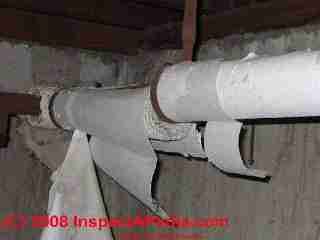 But we are uncertain about what asbestos pipe insulation treatment is needed at your property. Your inspector indicated that asbestos pipe insulation removal is needed; you indicated that asbestos encapsulation is planned. The asbestos test lab report that you provided simply confirms that the material contained asbestos. If it was conventional asbestos pipe insulation one could perhaps have known that even without testing.
But we are uncertain about what asbestos pipe insulation treatment is needed at your property. Your inspector indicated that asbestos pipe insulation removal is needed; you indicated that asbestos encapsulation is planned. The asbestos test lab report that you provided simply confirms that the material contained asbestos. If it was conventional asbestos pipe insulation one could perhaps have known that even without testing.
The need to remove asbestos and even the need to encapsulate is not at all absolute. Certainly encapsulating asbestos pipe insulation in areas where it needs to be protected from damage is advised.
When the material is damaged, releasing asbestos to the building, or when it is in a location where it is likely to be damaged and thus become a hazard, it is removed or encapsulated to protect it from damage.When asbestos pipe insulation is in good condition and located in an inaccessible area not exposed to damage, the remediator may advise you to leave the material alone.
There is no information in your note that addresses these questions, though of course you or an expert may have already made that assessment. (Also see ASBESTOS RISK ASSESSMENT).
If your pipe insulation looks like the asbestos material shown in our photo at left, indeed it's falling off and should be removed.
Proper asbestos pipe insulation removal involves more than unwrapping and disposing of the insulation.
The contractor will need to take measures to avoid spreading asbestos dust into the building (dust containment measures), and the pipes are usually cleaned and sometimes also sprayed with a sealant after the insulation itself is removed.
That said, the cost of removing asbestos pipe insulation has dropped quite a bit since the public anxiety over this topic has also faded, and as there are many asbestos removal companies.
We do not make individual contractor referrals, and we have no business nor financial relationship with companies who offer services, including some who may be listed at our website.
...
Continue reading at ASBESTOS REMOVAL GUIDE, FLOORING or select a topic from the closely-related articles below, or see the complete ARTICLE INDEX.
Or see these
Recommended Articles
- ASBESTOS IDENTIFICATION IN BUILDINGS - home
- ASBESTOS CLEANUP COMPANIES clean-up companies in who have expertise in asbestos removal.
- ASBESTOS REMOVAL, Amateur, Incomplete examples of amateur, incompetent environmental cleanup work involving asbestos.
- ASBESTOS REMOVAL CERTIFICATIONS
- MOLD CLEANUP COMPANIES
Suggested citation for this web page
ASBESTOS REMOVAL CERTIFICATIONS at InspectApedia.com - online encyclopedia of building & environmental inspection, testing, diagnosis, repair, & problem prevention advice.
Or see this
INDEX to RELATED ARTICLES: ARTICLE INDEX to ASBESTOS HAZARDS
Or use the SEARCH BOX found below to Ask a Question or Search InspectApedia
Ask a Question or Search InspectApedia
Try the search box just below, or if you prefer, post a question or comment in the Comments box below and we will respond promptly.
Search the InspectApedia website
Note: appearance of your Comment below may be delayed: if your comment contains an image, photograph, web link, or text that looks to the software as if it might be a web link, your posting will appear after it has been approved by a moderator. Apologies for the delay.
Only one image can be added per comment but you can post as many comments, and therefore images, as you like.
You will not receive a notification when a response to your question has been posted.
Please bookmark this page to make it easy for you to check back for our response.
IF above you see "Comment Form is loading comments..." then COMMENT BOX - countable.ca / bawkbox.com IS NOT WORKING.
In any case you are welcome to send an email directly to us at InspectApedia.com at editor@inspectApedia.com
We'll reply to you directly. Please help us help you by noting, in your email, the URL of the InspectApedia page where you wanted to comment.
Citations & References
In addition to any citations in the article above, a full list is available on request.
- 3/07: thanks to Gary Randolph, Ounce of Prevention Home Inspection, LLC Buffalo, NY, for attentive reading and editing suggestions. Mr. Randolph can be reached in Buffalo, NY, at (716) 636-3865 or email: gary@ouncehome.com
- 06/07: thanks for photographs of transite asbestos heating ducts, courtesy of Thomas Hauswirth, Managing Member of Beacon Fine Home Inspections, LLC and (in 2007) Vice President, Connecticut Association of Home Inspectors Ph. 860-526-3355 Fax 860-526-2942 beaconinspections@sbcglobal.net
- Thanks to reader GK October 2010 for discussing incompetent lead paint removal, lead paint dust contamination left indoors by the painting contractor, and how to clean up the lead paint dust mess.
- ASBESTOS IN YOUR HOME U.S. EPA, Exposure Evaluation Division, Office of Toxic Substances, Office of Pesticides and Toxic Substances, U.S. Environmental Protection Agency, Washington,D.C. 20460
- "Handling Asbestos-Containing roofing material - an update", Carl Good, NRCA Associate Executive Director, Professional Roofing, February 1992, p. 38-43
- EPA Guidance for Controlling Asbestos-Containing Materials in buildings, NIAST, National Institute on Abatement Sciences & Technology, [republishing EPA public documents] 1985 ed., Exposure Evaluation Division, Office of Toxic Substances, Office of Pesticides and Toxic Substances, U.S. Environmental Protection Agency, Washington,D.C. 20460
- In addition to citations & references found in this article, see the research citations given at the end of the related articles found at our suggested
CONTINUE READING or RECOMMENDED ARTICLES.
- Carson, Dunlop & Associates Ltd., 120 Carlton Street Suite 407, Toronto ON M5A 4K2. Tel: (416) 964-9415 1-800-268-7070 Email: info@carsondunlop.com. Alan Carson is a past president of ASHI, the American Society of Home Inspectors.
Thanks to Alan Carson and Bob Dunlop, for permission for InspectAPedia to use text excerpts from The HOME REFERENCE BOOK - the Encyclopedia of Homes and to use illustrations from The ILLUSTRATED HOME .
Carson Dunlop Associates provides extensive home inspection education and report writing material. In gratitude we provide links to tsome Carson Dunlop Associates products and services.


